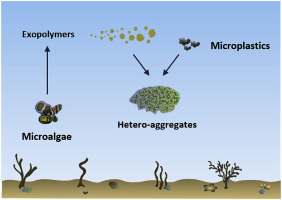Environmental Pollution ( IF 7.6 ) Pub Date : 2019-03-18 , DOI: 10.1016/j.envpol.2019.03.046 César Cunha , Marisa Faria , Natacha Nogueira , Artur Ferreira , Nereida Cordeiro

|
Microalgae can excrete exopolymer substances (EPS) with a potential to form hetero-aggregates with microplastic particles. In this work, two freshwater (Microcystis panniformis and Scenedesmus sp.) and two marine (Tetraselmis sp. and Gloeocapsa sp.) EPS producing microalgae were exposed to different microplastics. In this study, the influence of the microplastic particles type, size and density in the production of EPS and hetero-aggregates potential was studied. Most microalgae contaminated with microplastics displayed a cell abundance decrease (of up to 42%) in the cultures. The results showed that the formed aggregates were composed of microalgae and EPS (homo-aggregates) or a combination of microalgae, EPS and microplastics (hetero-aggregates). The hetero-aggregation was dependent on the size and yield production of EPS, which was species specific. Microcystis panniformis and Scenedesmus sp. exhibited small EPS, with a higher propension to disaggregate, and consequently lower capabilities to aggregate microplastics. Tetraselmis sp. displayed a higher ability to aggregate both low and high-density microplastics, being partially limited by the size of the microplastics. Gloeocapsa sp. had an outstanding EPS production and presented excellent microplastic aggregation capabilities (adhered onto the surface and also incorporated into the EPS). The results highlight the potential of microalgae to produce EPS and flocculate microplastics, contributing to their vertical transport and consequent deposition. Thus, this work shows the potential of microalgae as biocompatible solutions to water microplastics treatment.
中文翻译:

海洋与淡水微藻外聚合物作为微塑料污染的生物解决方案
微藻可以排泄外聚合物物质(EPS),并可能与微塑料颗粒形成异质聚集体。在这项工作中,两个淡水(潘氏微囊藻和Scenedesmus sp。)和两个海水(Tetraselmis sp。和Gloeocapsa)产生EPS的微藻暴露于不同的微塑料中。在这项研究中,研究了微塑料颗粒类型,大小和密度对EPS产生和异质聚集体潜力的影响。大多数被微塑料污染的微藻在培养物中显示出细胞丰度下降(最多42%)。结果表明,形成的聚集体由微藻和EPS(均质聚集体)组成,或由微藻,EPS和微塑料(异质聚集体)组成。异种聚集取决于EPS的大小和产量,这是特定于物种的。微型微囊藻和Scenedesmus sp。表现出较小的EPS,具有较高的分解倾向,因此聚集微塑料的能力较低。Tetraselmis sp。显示出较高的聚集低密度和高密度微塑料的能力,这部分受微塑料尺寸的限制。Gloeocapsa sp。具有出色的EPS产量,并具有出色的微塑料聚集能力(粘附在表面上,也并入EPS中)。结果突出了微藻产生EPS和絮凝微塑料的潜力,有助于它们的垂直运输和随之而来的沉积。因此,这项工作表明了微藻作为水微塑料处理的生物相容性解决方案的潜力。















































 京公网安备 11010802027423号
京公网安备 11010802027423号